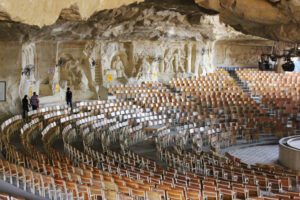The Cave Church and The Garbage city
The Cave Church, or the Monastery of Saint Simon, lies in the Muqattam Hills behind the Zabbalin village of garbage collectors. Reaching the monastery is a little difficult – you travel through a series of narrow village streets loaded with trash carts (hence the name Garbage City), and manoeuvre past plastic and tin which line the alleys. Even when described in detail, Zabbalin village is a hard place to picture – it can only be experienced first hand.
The monastery is famous for its unique churches and religious icons carved from the mountain rock. It plays an important social role among the people who live in the Garbage City as the majority of the fifty thousand people that live there are Christians.
What to see:
Saint Simon the Tanner Monastery:
At the far end of the village is the Monastery of Saint Simon. A stunning, vast cave church that lies in the heart of the hill. It has impressive carvings done by a Polish artist. Its coloured carvings spread across the mountain with scenes from The Bible.
Saint Simon lived towards the end of the 10th Century, when Egypt was ruled by the Fatimid Caliph Al- Mu’izz, and Anba Abram was the Coptic Pope. He worked in one of the crafts widespread in Babylon (old Cairo) at the which was tanning, a craft still known there until this day.
The monastery was erected in 1976 and dedicated to him a thousand years after his miracle and his death.
The main cathedral is in commemoration of Saint Simon and his task of transferring the Muqattam Mountain in 979 AD, according to Coptic teachings. It accommodates up to 20,000 people, and is the biggest church in the monastery.
The monastery also has an auditorium with a seating capacity of 2,000, as well as several churches and chapels hidden in a series of caves in the Muqattam hills, such as Saint Mark Church, Bishop Abram Church, Bishop Pula Church and Saint Simon Church. It has an educational centre with a kindergarten, a school for the deaf and dumb and literacy and vocational courses.
The unusual location coupled with the unexpected size of the caves and the beauty of the engravings, combine together make for a spectacular vision, astonishing by all means.
visiting the place is an exceptional experience that’s not to be missed.
The Garbage Village:
The Garbage Village, or Zabbalin village, was erratically established in 1969 when the President Nasser decided to move all the garbage collectors of Cairo to one of the hills of the Muqattam. At the beginning, around 15,000 people built themselves primitive houses of tin. Now, the number of trash collectors living in the area has reached about 40,000.
There the people sort and recycle the garbage produced by Cairo’s burgeoning population of millions. They start working in the early morning before the sun rises and go to every place in Cairo to collect garbage, and then go back to Muqattam as the sunsets where the trash is dumped and sorting begins. To reach Saint Simon’s Monastery, it is necessary to go through here.
Mother Teresa’s orphanage lies in the same area, this is a charity project aimed to support orphans and elders, especially those who have special needs.
The recycling centre is famous for its unique collection of items made from fabric, paper and flowers left over from clothes factories.

